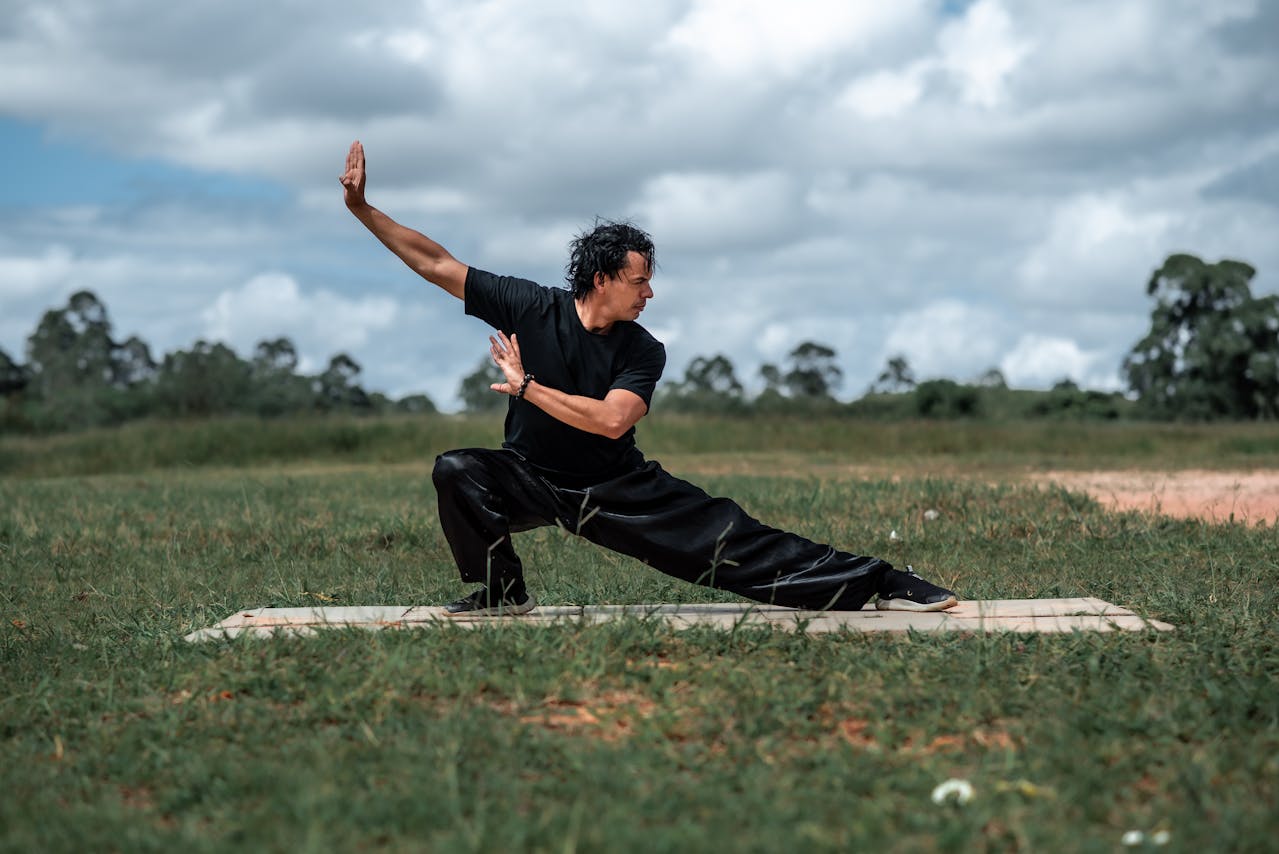
Table of Contents
Tai Chi is a form of moving meditation that joins the mind and body through a series of soft exercises. It’s a Chinese martial art focused on self-defense, self-awareness and health benefits dating back to the 13th century.
Key Takeaways
-
Tai Chi is a Chinese martial art that combines meditation, physical movements, and breathing techniques to enhance mental and physical health along with improved cognitive function.
-
It originated as a military exercise in the 13th century and has evolved into a popular form of exercise that improves balance, coordination, and stress management.
-
Tai Chi offers numerous health benefits, including better balance and coordination, stress reduction, and enhanced mental well-being. It also improve cardiovascular fitness.
-
Different styles of Tai Chi cater to various needs and preferences, such as Chen Style for explosive movements and Yang Style for slow, graceful motions.
 The Origins of Tai Chi
The Origins of Tai Chi
Tai Chi, also known as Tai Chi Chuan, is a form of Chinese martial arts originating in the 13th century. Tai Chi translates to Grand Ultimate, initially developed as a military training exercise for soldiers in ancient China.
Over time it evolved into a form of self-defense and eventually became a popular form of exercise and meditation. Today, people of all ages and abilities practice Tai Chi worldwide. It is a low-impact exercise that people of all fitness levels can enjoy.
Principles of Tai Chi

The principles of Tai Chi originate from the Chinese philosophy of yin and yang. Yin and yang are two opposite but complementary forces that make up the universe. By harnessing these forces, practitioners hope to achieve balance and harmony in their lives.
The goal of Tai Chi is to move the body in a slow, fluid, and relaxed manner. Tai Chi movements remind of “flowing like water” motions, as water is a yin and yang symbol in Chinese culture. The exercise is graceful and accompanied by deep breathing.
Tai Chi can be compared to fast walking and resistance training when practiced regularly. Although you aren't working with weights or resistance bands, the unsupported arm exercise in Tai Chi strengthens your upper body.
Tai Chi is not just a physical exercise but also a form of meditation, and focusing on the mind-body connection is key to achieving Tai Chi's benefits. With the mind focused and the body relaxed, practitioners can achieve a state of inner peace and harmony.
It can be practiced solo or in tai chi class, and there is no need for special equipment or clothing. All you need is a comfortable place to practice and enough space to move around freely.
Tai Chi can be an excellent way to improve your physical health and psychological well-being. If you are looking for a low-impact exercise suitable for people of all ages and fitness levels, Tai Chi may be the right choice.
Health Benefits of Tai Chi
Tai Chi is a gentle exercise with many mental and physical health benefits. Many clinical studies exploring Tai Chi's effect on specific diseases and health conditions demonstrate that the ancient martial art practice can be used in alternative therapies. Some of the benefits include:
Improved Balance and Coordination
Tai Chi training helps with improving balance and coordination by practicing slow, deliberate movements that build muscle strength, as well as helping to reduce the risk of falls, especially in older adults.
Improved Heart Health
Tai Chi improves heart health by reducing blood pressure and cholesterol levels. A recent randomized controlled trial published in the journal Heart & Lung found adults with hypertension who trained in Tai Chi for six months had significantly lower blood pressure and body mass index than those receiving their usual care for hypertension.
Stress Reduction and Improved Mental Health
Tai Chi is a form of moving meditation, and like other forms of meditation, it can help reduce stress and improve mental health. The slow, gentle movements of Tai Chi are soothing and relaxing on the mind and body.
One peer-reviewed study compared Tai Chi interventions to usual care or other exercises in people with chronic health conditions. It found that the Tai Chi group with coronary heart disease had better mental health and quality of life, those with chronic heart failure experienced less depression and psychological distress, and those with high blood pressure had better physical health.
Improved Overall Well-being
Tai Chi practice can improve practitioners’ quality of life by enhancing general health. Through a randomized control trial, Tai Chi participants for five one-hour sessions. Scientists found that those with usual care and Tai Chi practice experienced lower general, physical, and emotional fatigue than those who only received routine care.
Meditation in motion has many other health benefits, from improved sleep quality and enhanced immune system to stronger physical health. Tai Chi helps to treat and prevent chronic diseases, including mild cognitive impairment and chronic obstructive pulmonary disease.
In some cases, Tai Chi is even used as a form of physical therapy for rheumatoid arthritis, knee osteoarthritis, and other chronic conditions.
How is Tai Chi Different from Yoga?

While both Tai Chi and yoga are slow, gentle forms of mind-body exercise that have many similar benefits, there are some critical differences between the two. Tai Chi is a martial art that originated in China, while yoga originated in India.
Tai Chi movement is smooth and continuous, while yoga includes various physical postures, breathing exercises, and meditation. Finally, Tai Chi does not require special equipment or clothing, while yoga often requires mats and other props.
The Different Styles of Tai Chi
There are many different Tai Chi forms, each with its unique focus. Some emphasize martial arts, while others focus on healing and stress reduction. The most popular styles include:
Chen Style
The original Tai Chi style characterized by fast movements and explosive power.
Yang Style
Yang style is the most popular style of Tai Chi and incorporates slow, graceful movements.
Wu Style
This style of Tai Chi emphasizes balance and control.
Sun Style
This style of Tai Chi is known for its long, flowing movements.
Seated Tai Chi
This style is ideal for older folks to improve symptoms of arthritis.
Starting Tai Chi
If you are interested in learning Tai Chi, several options are available. Many books and videos can teach the basic movements of the form, and most local rec centers offer Tai Chi classes. Finding someone experienced and reputable is essential when choosing a class or teacher. Tai Chi is a safe exercise, but like any physical activity, there is a risk of injury.
Once you have learned the basic movements, you can practice Tai Chi at home or in a class. Tai Chi can be done solo or in groups making it flexible to fit your schedule, and there is no need for special equipment or clothing. You only require a comfortable place to practice and enough space to move around freely.
Frequently Asked Questions
Is Tai Chi Difficult to Learn?
No, Tai Chi is not challenging to learn. The movements are slow and gentle, and people of all ages and fitness levels can understand them. There are also many different styles of Tai Chi, so you can find one that best suits your needs and abilities.
How Often Should I Practice Tai Chi Before Seeing Results?
Practicing Tai Chi three to four times weekly results in the most potent benefits. However, you may start seeing some benefits after just a few sessions.
Is Tai Chi Safe?
Yes, Tai Chi is a safe form of exercise for most people. However, as with any exercise, there is always a risk of injury. Be sure to warm up before practicing Tai Chi, and listen to your body if you experience any pain or discomfort.
How to Choose my Tai Chi Instructor?
There's no formal training or licensing for Tai Chi instructors, so you'll need to rely on recommendations from friends or clinicians and, of course, your judgment. Look for an experienced teacher who will accommodate individual health concerns or levels of coordination and fitness.
Is it Possible to Learn Tai Chi Online?
You can learn Tai Chi from video tutorials on Youtube or online streaming platforms, but taking classes with a certified instructor is highly recommended. Tai Chi is different from yoga because it is a martial art and exercise. It would help if you practiced Tai Chi three to five times weekly to see results.
What Are the Health Benefits of Tai Chi?
Tai Chi has many health benefits, including improved circulation, heart health, increased energy levels, and joint health. It is also a great way to reduce stress and relax the mind and body.
References
Tai Chi Chuan improves functional capacity after myocardial infarction: A randomized clinical trial.
Exploring the basis for Tai Chi Chuan as a therapeutic exercise approach - ScienceDirect
Tai Chi research review - ScienceDirect
A Comprehensive Review of Health Benefits of Qigong and Tai Chi
A Randomized Trial of Tai Chi for Fibromyalgia | New England Journal of Medicine
Disclaimer
The contents of this article are provided for informational purposes only and are not intended to substitute for professional medical advice, diagnosis, or treatment. It is always recommended to consult with a qualified healthcare provider before making any health-related changes or if you have any questions or concerns about your health. Anahana is not liable for any errors, omissions, or consequences that may occur from using the information provided.

By: Meriah McCauley
Meriah McCauley is a leading voice in holistic healing, known across North America for her expertise in chakra balancing, spiritual alignment, and energy-based wellness. Her work bridges the art and science of mind-body healing, shaped through years of study, practice, and mentorship. Meriah deepened her understanding of spiritual anatomy and the chakra system under the guidance of her guru, Dr. Don Stapleton, during her immersive training in Costa Rica. She later earned her Master’s degree in Psychology from Columbia University, specializing in Spirituality and the Mind–Body connection, which continues to influence her integrative approach. Today, she supports individuals and practitioners through coaching, yoga teacher trainings, chakra-focused education, and Holotropic Breathwork for personal transformation. Meriah is dedicated to helping others develop emotional clarity, energetic balance, and spiritual resilience—and she remains committed to guiding anyone seeking a deeper, more meaningful connection with themselves.